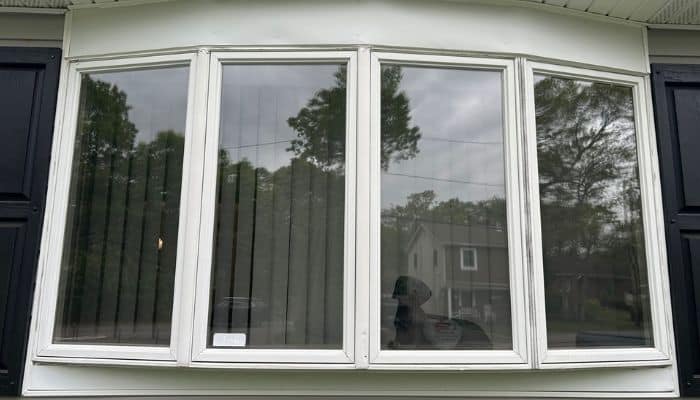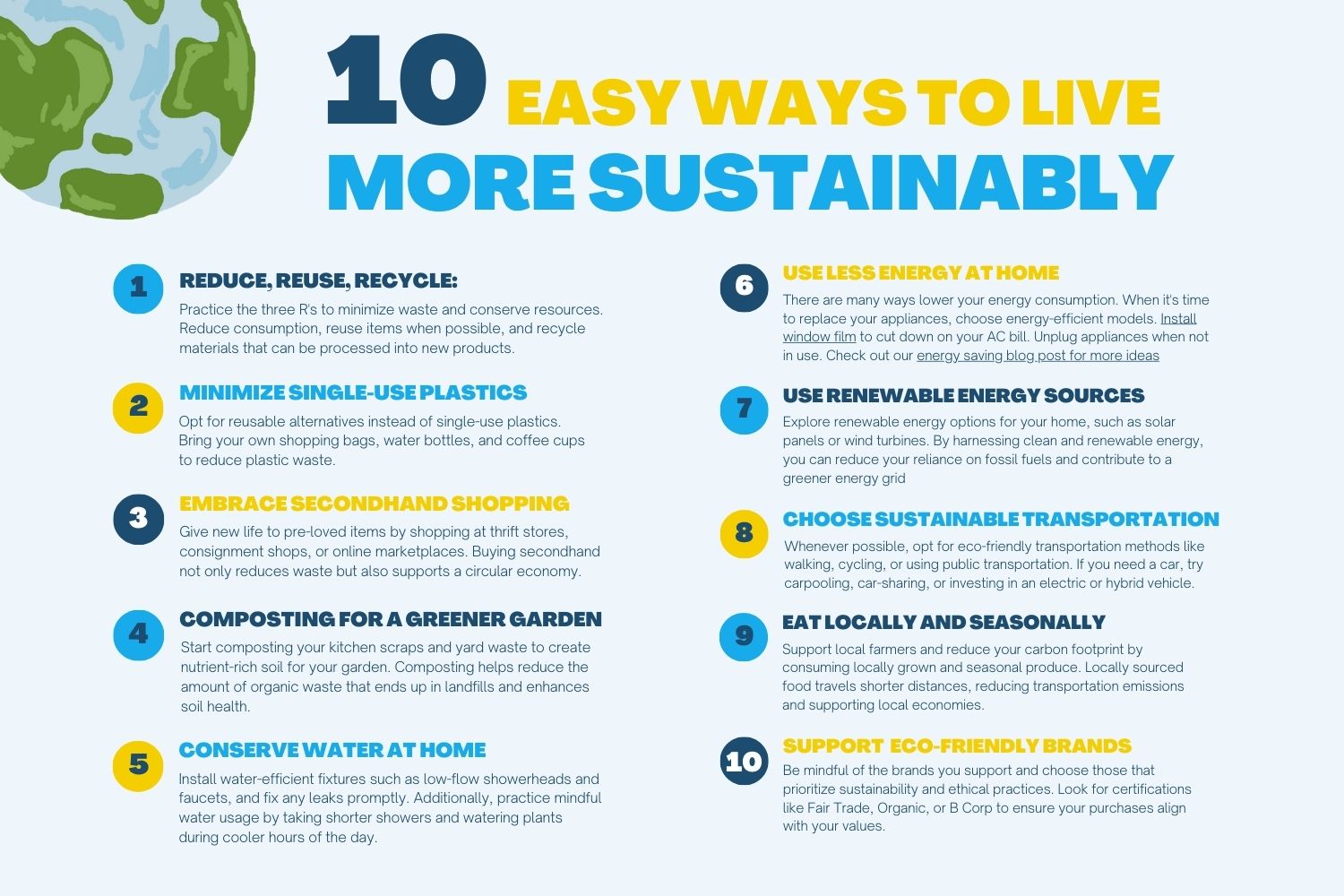
Trusted by Thousands of Homeowners Across the U.S.
Trusted by Thousands of Homeowners Across the U.S.

In today’s world, where environmental concerns are at the forefront, adopting sustainable practices has become increasingly important. Living more sustainably not only helps to reduce our ecological footprint but also contributes to the overall well-being of our planet. In this article, we will explore ten easy ways to live more sustainably in our daily lives and make a positive impact on the environment.
Sustainability is the concept of meeting the needs of the present generation without compromising the ability of future generations to meet their own needs. It involves finding a balance between environmental, social, and economic factors to ensure a harmonious coexistence with nature and society.
Sustainability rests upon three pillars: environmental, social, and economic. These pillars are interconnected and should be considered together when making sustainable choices. Only by addressing all three aspects, we can create a more equitable and resilient future for all:
This is concerned with the impact of human activities on the natural world. It involves managing these activities in such a way as to ensure the long-term quality and viability of the Earth’s ecosystems. Issues of focus include pollution, waste management, resource depletion, biodiversity loss, and climate change. The goal is to meet present needs without compromising the ability of future generations to meet their own needs, particularly with respect to the natural environment and resources.
This pillar is about ensuring that the economic activities which provide jobs, infrastructure, and services today are managed in a way that they will continue to do so for future generations. It emphasizes the importance of economic growth and development, but also the need for economic activities to be ecologically and socially sustainable. Economic sustainability is also about ensuring that all members of society have their basic economic needs met, including food, clothing, and shelter, and have an equitable opportunity for personal and social development.
This focuses on maintaining and improving social quality and achieving equity in society. It involves issues such as human rights, social justice, community development, education, health, and cultural preservation. It requires that the needs of all people are met, their quality of life is improved, and inequality is reduced. Social sustainability aims at promoting a sense of belonging, respect, and value among people, while at the same time establishing structures and institutions that support those goals.
The interaction between these three pillars is crucial for achieving sustainability. None can be achieved without the others. For instance, protecting the environment won’t be sustainable if it leads to economic downfall or social injustice. Similarly, economic growth won’t be sustainable if it causes environmental degradation or deepens social inequalities. The concept of sustainability emphasizes the need for a balanced approach that considers all three aspects.
Sustainable living is vital because it allows us to preserve natural resources, protect biodiversity, and mitigate climate change for future generations. Earth’s resources are finite. Over-exploitation of these resources such as water, air, soil, minerals, forests, and energy can lead to their depletion. Sustainable living practices ensure that we use these resources judiciously so that future generations can also benefit from them.
By embracing sustainable practices, we can reduce waste, conserve energy and water, support ethical production, and foster a more sustainable economy. Our individual actions, when combined, can create a significant positive impact on the world. So let’s jump into our 10 easy ways to live more sustainably!
Practice the three R’s to minimize waste and conserve resources. Reduce consumption, reuse items when possible, and recycle materials that can be processed into new products.
Opt for reusable alternatives instead of single-use plastics. Bring your own shopping bags, water bottles, and coffee cups to reduce plastic waste.
Give new life to pre-loved items by shopping at thrift stores, consignment shops, or online marketplaces. Buying secondhand not only reduces waste but also supports a circular economy.
Start composting your kitchen scraps and yard waste to create nutrient-rich soil for your garden. Composting helps reduce the amount of organic waste that ends up in landfills and enhances soil health.
Install water-efficient fixtures such as low-flow showerheads and faucets, and fix any leaks promptly. Additionally, practice mindful water usage by taking shorter showers and watering plants during cooler hours of the day.
There are many ways to lower your energy consumption. When it’s time to replace your appliances, choose energy-efficient models. Install window film to cut down on your AC bill. Unplug appliances when not in use. Check out our energy-saving blog post for more ideas.
Explore renewable energy options for your home, such as solar panels, community solar farms, or wind turbines. By harnessing clean and renewable energy, you can reduce your reliance on fossil fuels and contribute to a greener energy grid.
Whenever possible, opt for eco-friendly transportation methods like walking, cycling, or using public transportation. If you need a car, consider carpooling, car-sharing, or investing in an electric or hybrid vehicle.
Support local farmers and reduce your carbon footprint by consuming locally grown and seasonal produce. Locally sourced food travels shorter distances, reducing transportation emissions and supporting local economies.
Be mindful of the brands you support and choose those that prioritize sustainability and ethical practices. Look for certifications like Fair Trade, Organic, or B Corp to ensure your purchases align with your values.
When it comes to adopting sustainable practices, every small step counts. Window film presents a simple yet impactful way to contribute to a greener future. And among the DIY options, Concord Window Film stands out as a reliable choice that combines effectiveness, convenience, and sustainability.
By installing Concord Window Film, individuals and businesses can reduce their energy consumption and carbon footprint. The film’s sun blocking properties help maintain a comfortable indoor temperature, minimizing the need for excessive cooling. This not only leads to lower energy bills but also decreases the demand for fossil fuel-based energy sources, thereby reducing greenhouse gas emissions.
Plus, Concord Window Film offers excellent UV protection. Harmful ultraviolet rays can cause fading and damage to furniture, flooring, and other valuables. By blocking up to 99% of UV radiation, this film helps preserve the longevity and beauty of interior spaces while minimizing the need for replacements and reducing waste.
Additionally, Concord Window Film is designed to be long-lasting and low-maintenance. Its scratch-resistant surface ensures durability and ensures that the film retains its effectiveness over time. This eliminates the need for frequent replacements and further reduces waste generation.
By choosing Concord Window Film you can make a tangible and immediate impact on your sustainability efforts. The film’s energy efficiency, UV protection, ease of installation, and longevity combine to create an environmentally friendly solution that promotes a more sustainable lifestyle.
In a world where small changes can make a big difference, embracing window film as a sustainable choice is a step towards a greener future. With Concord Window Film, you can effortlessly enhance your living or working spaces while reducing your environmental footprint. So, why wait? Join the movement towards sustainability today and make a positive change for our planet.